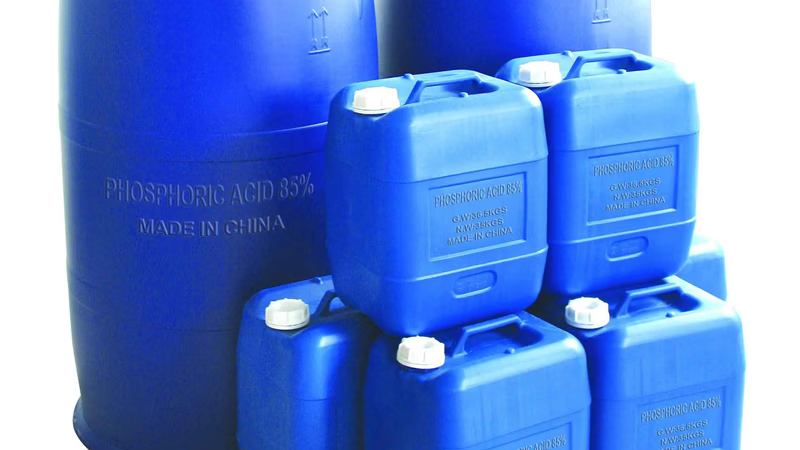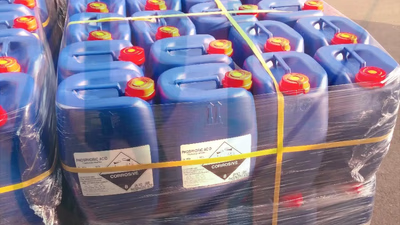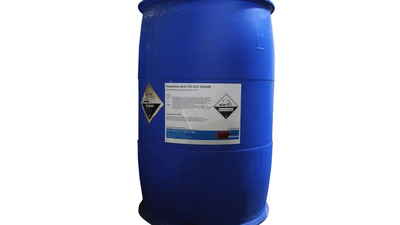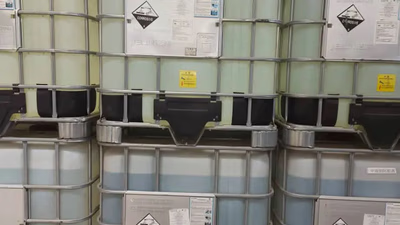
Phosphoric acid production facilities enhance Middle East trade.
West Asia is home to several countries with significant phosphoric acid production capacity. Key producers in the region include Saudi Arabia, Jordan, and Morocco. These countries have abundant phosphate rock reserves, which serve as the primary raw material for phosphoric acid production. The Middle East is a major producer and exporter of phosphate-based fertilizers, which rely on phosphoric acid as a key ingredient. Phosphoric acid is used in the production of various phosphate fertilizers such as diammonium phosphate (DAP), monoammonium phosphate (MAP), and triple superphosphate (TSP). The region's favorable access to phosphate reserves and its strategic location for fertilizer trade have contributed to the growth of the phosphoric acid market.
Phosphoric acid finds applications beyond the fertilizer industry in West Asia. It is used in various industrial sectors, including chemicals, detergents, food and beverages, and metal treatment. The region's growing industrialization and expanding manufacturing base have created a demand for phosphoric acid in these sectors. West Asia is a major exporter of phosphoric acid, supplying the product to global markets. Countries in the region, such as Saudi Arabia, Jordan, and Morocco, have established themselves as key players in the international phosphoric acid trade. They benefit from their proximity to phosphate reserves, lower production costs, and access to shipping routes for export.
The phosphoric acid market in West Asia is expected to continue growing, driven by factors such as population growth, increasing food demand, and the need for improved agricultural productivity. Investments in research and development to enhance production efficiency and reduce environmental impact are expected to shape the future of the industry. The feedstock of phosphoric acid production units in the Middle East is provided by the import of phosphate soils and petrochemicals. Most of these manufacturers operate under the license and basic engineering of foreign companies with 100% private ownership. Countries' need for phosphoric acid as a raw material for the production of chemical fertilizers and livestock and poultry food supplement encourages Middle Eastern investment companies to build these plants.
These projects, with their high potential for development, can bring high export earnings if invested. Most Middle Eastern countries import phosphoric acid. Due to the low production of phosphoric acid in the Middle East, the need for this product is met through its import. Imported phosphoric acid entered in the form of a seal in 20-liter (35 kg) packages and 1000-liter (1650 kg) storage tanks. New contracts have been signed for the construction of phosphoric acid plants, but by 2025 these units will not be operational. For example, 250 million euros will be invested in this field by the National Iranian Copper Industrial Company. National Iranian Copper Company will need 1.2 million tons of phosphate soil annually to produce phosphate fertilizer.
The Middle East has made significant investments in infrastructure and production facilities to support the phosphoric acid industry. Countries like Saudi Arabia have developed large-scale integrated phosphate complexes, which include phosphate rock mining, phosphoric acid production, and fertilizer manufacturing. These investments have boosted the region's capabilities in phosphoric acid production and enhanced its competitiveness in the global market. The phosphoric acid market in West Asia is influenced by factors such as global demand for fertilizers, agricultural practices, raw material availability, environmental regulations, and international trade policies. Price fluctuations in phosphate rock, sulfur, and energy sources can also impact the market dynamics in the region.
-

Phosphoric acid, or orthophosphoric acid, is a mineral acid with the formula H₃PO₄. It is produced through either the wet or thermal process. The wet process involves reacting phosphate rock with sulfuric acid, resulting in a mixture that is filtered and purified to yield phosphoric acid. This triprotic acid has a pH of around 2. 2, indicating its strong acidity. Phosphoric acid is widely used in various industries, particularly in food and beverages as a flavor enhancer and preservative. It plays a crucial role in the production of phosphate-based fertilizers like DAP and MAP, essential for plant growth. Additionally, it is utilized in metal surface treatment and the synthesis of pharmaceuticals and detergents.
While generally safe when handled properly, concentrated phosphoric acid can cause burns and eye damage; thus, protective equipment is necessary during handling. Its applications extend across agriculture, food processing, cosmetics, and industrial processes.
-

Phosphoric acid is a versatile compound utilized across various industries due to its ability to adjust pH levels. In the food and beverage sector, it serves as an acidulant and flavor enhancer, commonly found in carbonated drinks and processed foods. Its role in agriculture is significant, as it is a key ingredient in phosphate-based fertilizers that promote plant growth by replenishing soil phosphorus. Additionally, phosphoric acid aids in water treatment by controlling alkalinity and preventing scale formation in cooling towers and boilers. It also finds applications in chemical manufacturing, where it acts as a reactant or catalyst for producing phosphate salts used in detergents and pharmaceuticals. The cleaning properties of phosphoric acid make it effective for rust removal and metal surface preparation. Overall, its diverse applications highlight its importance in enhancing product quality and supporting various industrial processes.
-

West Asia, particularly Saudi Arabia, Jordan, and Morocco, is a significant player in the phosphoric acid market due to its abundant phosphate rock reserves. These countries are major producers and exporters of phosphate-based fertilizers, which utilize phosphoric acid as a key ingredient. The region"s strategic location and access to resources have fostered growth in the phosphoric acid sector. Beyond fertilizers, phosphoric acid is utilized in various industries such as chemicals, food and beverages, and metal treatment. The increasing industrialization in West Asia has heightened demand for this versatile compound. Despite being a major exporter, the Middle East also imports phosphoric acid to meet local needs due to lower production levels. Investments in new production facilities are underway but will not be operational until after 2025. For instance, the National Iranian Copper Industrial Company plans to invest 250 million euros into developing phosphoric acid plants that will require substantial phosphate soil imports annually.
The market is expected to grow driven by population increases and rising food demands while facing challenges from price fluctuations and environmental regulations. Overall, the region"s investments in infrastructure and production capabilities position it competitively within the global phosphoric acid market.
-

Phosphoric acid production primarily utilizes the wet process, where phosphate rock is mined, ground, and reacted with sulfuric acid to yield phosphoric acid and calcium sulfate. This method is favored for its lower energy requirements and higher purity of the final product. The wet process involves filtering the mixture to separate solid calcium sulfate from liquid phosphoric acid, which is then concentrated through evaporation. An alternative method, the thermal process, involves burning elemental phosphorus to produce phosphorus pentoxide, which is then dissolved in water to form phosphoric acid. While both methods have their pros and cons, the wet process remains dominant due to its efficiency. Environmental sustainability is becoming a key focus in production practices, with efforts aimed at reducing waste and minimizing ecological impacts. Historical context reveals that phosphoric acid has been recognized for its agricultural benefits since the 19th century, leading to its widespread use as a fertilizer. As industries evolve, sourcing reliable phosphate mineral ores has become essential due to past challenges with bone prices.
-

Phosphoric acid, derived from phosphorus, has a rich history dating back to the late 17th century when Hennig Brand first isolated phosphorus. The understanding of phosphoric acid evolved significantly in the early 19th century through the work of chemists like Jöns Jacob Berzelius. Initially produced via the bone-ash process, which treated bones with sulfuric acid, commercial production began in the mid-19th century. The wet process emerged in the early 20th century, replacing the bone-ash method due to its efficiency. The molecular structure of phosphoric acid (H₃PO₄) was elucidated in the late 19th century, leading to its widespread use in agriculture as a fertilizer and in various industries such as detergents and food production. Phosphoric acid became essential for enhancing crop yields and was later recognized for its role as an acidulant in beverages. Regulatory bodies have since established safety standards for its use in food products. However, environmental concerns regarding phosphate mining and processing have prompted efforts to improve sustainability within the industry.





